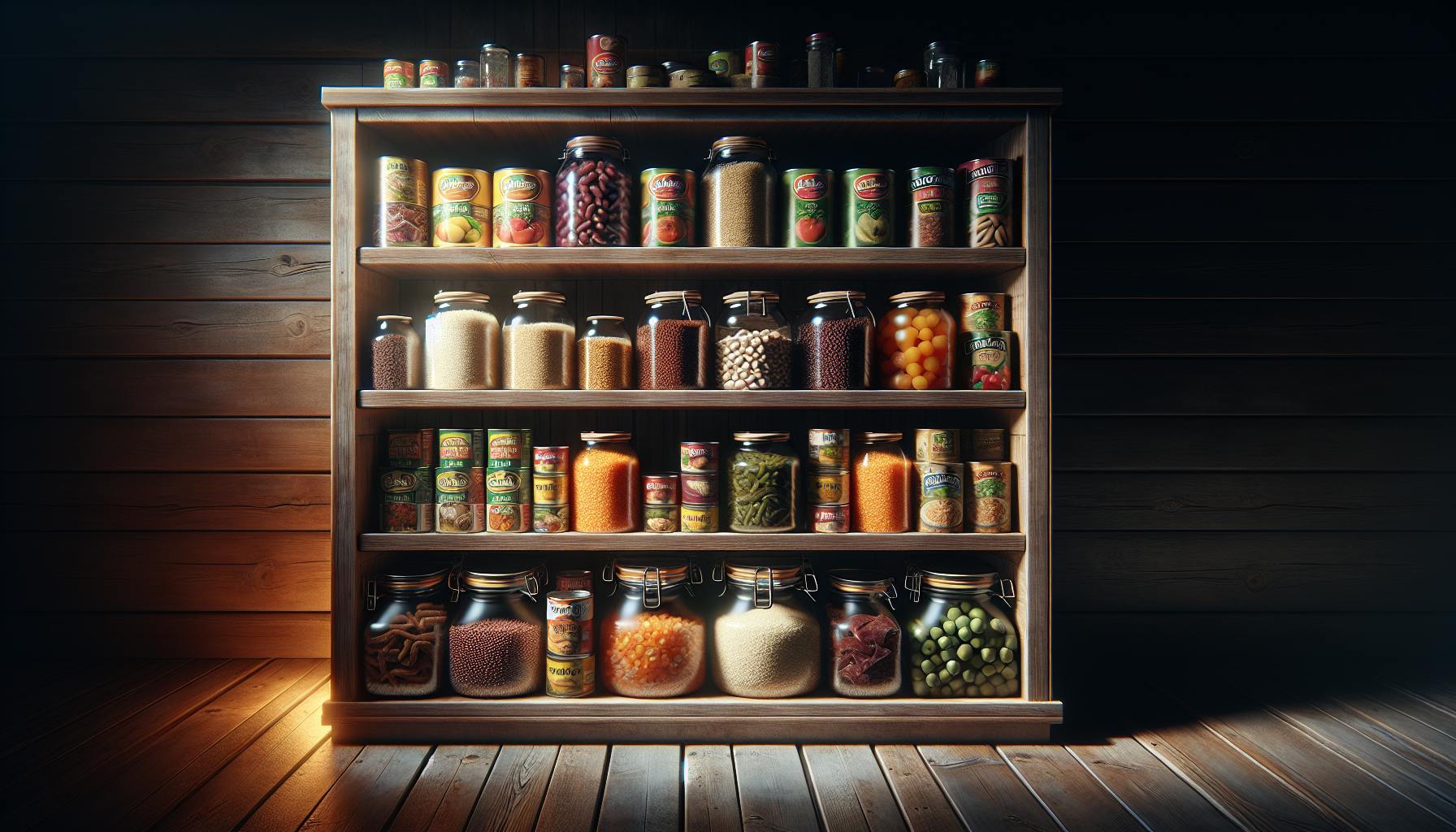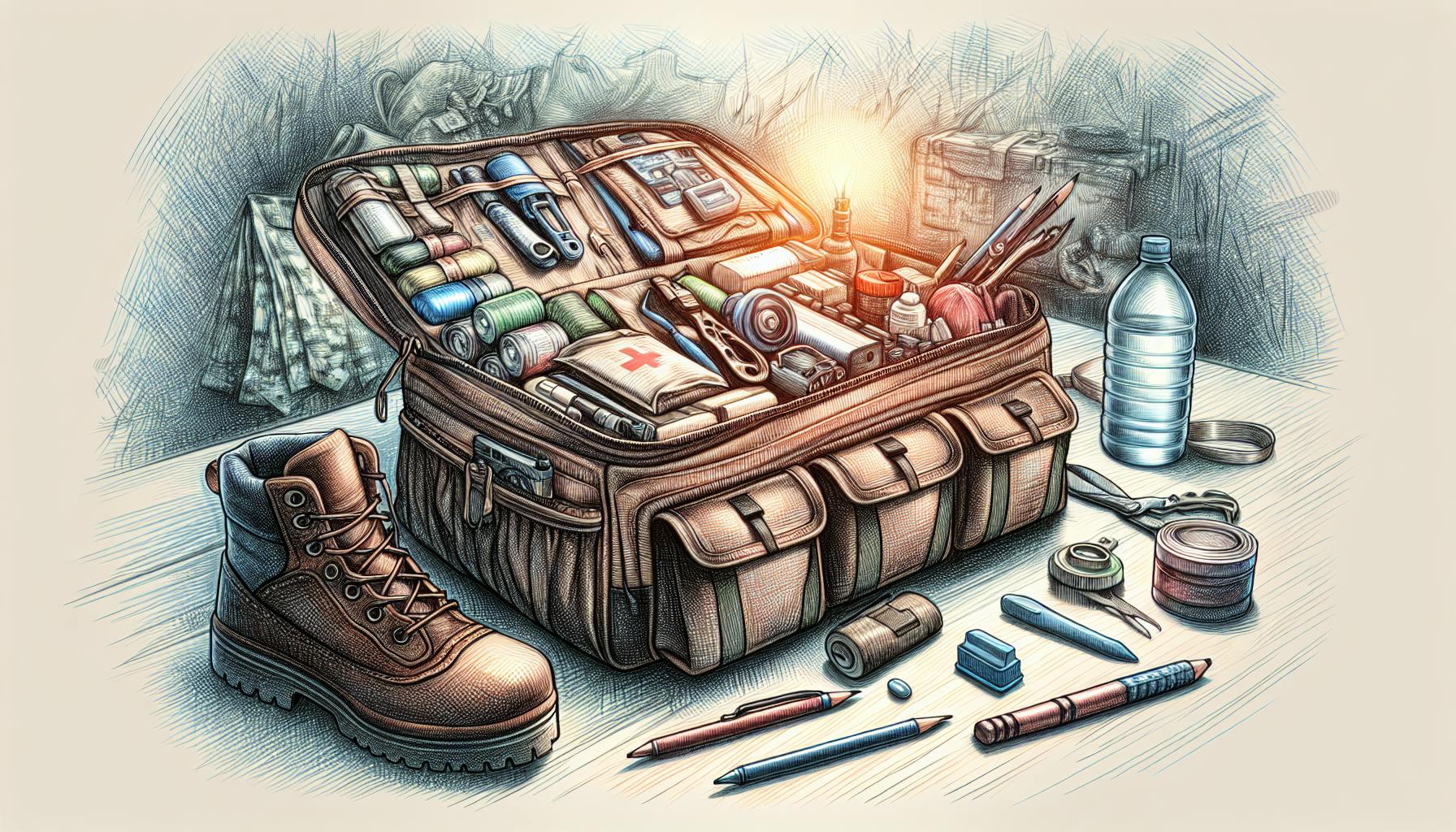When it comes to survival preparedness, most people would agree that having the right gear on hand is critical for handling emergencies.
In this post, we'll compare DIY and pre-made survival kits to help you make an informed decision on the best survival kit for your needs.
You'll learn the core components every survival kit requires, weigh the pros and cons of crafting your own kit versus buying a ready-made option, and get checklists and recommendations for choosing or building the ideal survival pack for different situations.
Introduction to Survival Kit Essentials
A well-stocked survival kit is an essential part of emergency preparedness. When an unexpected crisis hits, having the right tools and supplies on hand can make a life-saving difference. But building an effective survival kit requires some key considerations. Should you piece together your own custom kit, or opt for a convenient pre-made solution? We'll examine the pros and cons to help you decide.
Understanding the Components of a Survival Kit
The best survival kits include gear to meet basic needs for shelter, water, food, first aid, navigation, and signaling/communication. Key items to consider packing include:
- Shelter: Tarp, emergency blanket, cordage
- Water: Purification tablets, collapsible water bottle
- Food: High-calorie bars, pouches of freeze-dried meals
- First Aid: Bandages, ointments, medications
- Navigation: Map, compass, GPS device
- Signaling: Whistle, signal mirror, flare
When assembling your kit, tailor the specific items to your intended application, whether everyday carry, wilderness excursions, or disaster preparedness at home.
Customization vs. Convenience: The DIY and Pre-Made Dilemma
DIY survival kits allow you to hand-pick every item to create a fully customized, personalized kit catered to your exact needs and preferences. However, this approach requires extensive research and planning to source and compile suitable gear.
Pre-made, commercial survival kits offer convenience and simplicity, pulling together vetted essentials into a ready-to-go package. But these kits tend to be one-size-fits-all, and may include less than ideal items or exclude key pieces you specifically need.
Assessing Your Survival Kit Needs
When deciding between a DIY or pre-made survival kit, first assess your intended uses, duration of use, climate/terrain, group size, skill level, and available budget. Consider your personal risk factors and situations you're preparing for. These parameters will dictate your ideal kit contents and whether convenience or customization should take priority. Proper planning is key to ensuring you have the right gear on hand to overcome any challenges you may face.
DIY Survival Kits: Crafting Your Own
Constructing your own survival kit allows you to customize the contents to your specific needs, budget, and situation. However, it does require more effort and knowledge on your part.
Advantages of a Personalized DIY Survival Kit
- You can tailor the gear to your unique needs, skills, climate, etc.
- It allows you to stay within your specific budget constraints.
- You learn useful skills and knowledge in the process.
- It can be a fun project to work on with family or friends.
Challenges and Pitfalls of DIY Survival Kits
Assembling your own kit has some potential downsides to be aware of:
- It takes time and effort to research and source all the right gear.
- You may overlook some critical items without the proper knowledge.
- Testing gear adequacy takes additional time and effort.
- Budget limitations can lead to lower quality gear selections.
Avoid these common DIY pitfalls by thoroughly researching reputable prepper sources when choosing your gear. Test it under various conditions.
Tools and Resources for Building the Best Survival Kit
Equip yourself with the right knowledge by referencing prepper books and quality online resources. Useful tools include:
- Detailed survival checklists
- Reviews of various gear options
- Online calculators to customize your kit
- Videos demonstrating key techniques
Leverage these tools to make informed decisions when assembling your DIY survival kit.
Best Survival Kit Checklist for DIY Enthusiasts
Those looking to build their own kit should consider including:
- Water purification supplies
- First aid components
- Fire starting tools like matches, lighters
- Signaling devices like mirrors, whistles
- Shelter items like emergency blankets
- Multi-tools and key devices like knives, paracord
- Food rations and cooking equipment
Research and test which specific items in these categories make the most sense for your situation. Customize accordingly while covering all the bases.
sbb-itb-b932644
Pre-Made Survival Kits: Off-the-Shelf Solutions
Pre-assembled survival kits provide a convenient, affordable way to get basic disaster preparedness supplies quickly. However, their generalized nature means they may not be tailored to your specific needs. Weighing the pros and cons of both pre-made and DIY survival kits can help you make an informed decision.
Convenience of Pre-Made Survival Kits
Ready-made survival kits offer the following benefits:
- Convenience - Pre-assembled kits allow you to skip researching and gathering supplies. Just order and you'll have the basics for short-term survival.
- Affordability - Mass produced kits are relatively inexpensive, good for those on a tight budget. Prices range from $50-$150.
- Portability - Many pre-made kits come in handy backpacks or cases for grabbing and going.
However, the convenience and affordability means less customization to your situation.
Limitations of Off-the-Shelf Survival Kits
Potential downsides of generalized, pre-made survival kits:
- May lack items needed for your specific location, season, climate.
- Often missing specialized items like medications, pet food.
- Cheaper kits may lack comprehensive food/water for longer than 3 days.
- Quality of items may be uneven from mass production.
- Difficult to tailor for individual allergies/health issues.
While handy for basic disaster prep, evaluate if one-size-fits-all kits truly meet your needs.
Best Survival Kit on Amazon for Quick Preparedness
For those seeking an affordable, ready-to-go option, Surviveware's Small Survival Kit is a top choice with 4.7/5 stars. At under $60, it packs 2-person, 2-day essentials into a portable case. Quality basics for the price.
Other well-rated choices in the $100 range are Ready America's 70385 Deluxe Emergency Kit Backpack and Emergency Zone's Urban Survival Bug Out Bag. Both offer handy checklists so you can verify what's included.
When choosing the best survival kits on Amazon, read item details closely and check reviews. Many kits promise more than they deliver.
Evaluating the Best Survival Kits of 2023
While Amazon has affordable options, specialty retailers like My Medic, Uncharted Supply, and Emergency Prep offer more premium emergency kits in the $200+ range.
Key factors in evaluating quality:
- Customization - Can the kit be tailored to your situation with add-ons?
- Portion sizes - Check food/water rations for adequate calories.
- Expiration dates - Ensure any food, water, medicine isn't expired.
- Materials - Durability of bags, tools, accessories under harsh conditions.
- Reputation - Read reviews and brand background for quality assurance.
The right preparedness survival kit balances your budget, risk factors, and need for customization. Evaluate both DIY and pre-made options using the criteria above before deciding what meets your situation best.
Tailoring Survival Kits for Specific Scenarios
When creating or purchasing a survival kit, it's important to consider your specific needs and scenario. An urban dweller, wilderness camper, and suburban family all require different gear to safely endure a disaster. We'll explore tailored recommendations for various situations.
Best Survival Kit for Camping and Wilderness Adventures
For those venturing into the wilderness, items like a fire starter, water purification tablets, and a signaling device are essentials. A lightweight, compact kit is also key. We recommend the Ultimate Survival Technologies Outdoor Survival Kit for its portability and inclusion of key tools like a folding knife, emergency blanket, and mini first aid supplies. Those with more advanced skills can build their own custom wilderness survival kit, but a pre-made option removes guesswork.
Urban Survival Kits: Staying Safe in the Concrete Jungle
Urban disasters like blackouts, infrastructure failure, riots, etc. require gear for self-defense, communication, light sources, and mobility. We suggest the Ready America 70385 Urban Survival Kit for its hand crank radio, dust masks, light sticks, and other urban-focused items. For self-defense, we'd add pepper spray and a loud personal alarm. With space at a premium, an urban kit should contain only the most vital items.
Best Survival Kits for Families: Group Preparedness Solutions
For households with multiple family members, the Stealth Angel Survival Kit for Family of 4 provides cost-effective disaster preparedness. It contains basic medical supplies, food rations, hygiene items, and other essentials tailored for groups. Larger families can scale up by purchasing multiple kits. Those able to invest more might opt for a custom family kit with additional gear like walkie-talkies, glow sticks, and family-oriented first aid.
Customizing the Best Survival Kit for Families
When creating your own family survival kit, be sure to include items suited for all members - children, elders, pets, etc. We recommend packing comfort foods, games/toys, and a family emergency plan alongside standard gear like flashlights, batteries, masks, blankets, and radios. Get input from the whole family when deciding what to include. Allow each member to personalize their own mini survival tin with special items. By making it a family affair, everyone becomes invested in your emergency preparedness.
Conclusion: Making the Right Choice for Your Survival Needs
Synthesizing the Survival Kit Decision
When deciding between a DIY or pre-made survival kit, consider your skill level, time commitment, budget, and specific emergency preparedness needs.
If you are new to prepping, a pre-made kit can provide an excellent starting point with carefully curated supplies. However, customizing the contents to your unique situation may require augmenting the kit further. DIY kits allow complete personalization but demand more research and effort.
Evaluate if you have the knowledge to hand-pick equipment and medically-approved food/water for your family or group size. Premade kits remove the research burden but may overlook specialized regional risks.
Finally, analyze costs over time - DIY allows staged purchasing but requires upfront effort. Pre-made simplifies the process for a higher upfront cost. Choose based on your budget and willingness to incrementally build supplies.
Final Thoughts on Best Survival Kit Practices
Regardless if you DIY or buy pre-made, adhere to best practices around organization, storage conditions, and expiration dates.
Keep an inventory list updated for quick access during an emergency. Store kits in easy access but protected locations - consider waterproof containers. Check and replace expired medical supplies, food, and water every six months.
Following these guidelines helps ensure your survival supplies remain in peak condition when they are needed most. An outdated first aid kit in disarray will be essentially useless. Invest in organization now for effective preparedness later.


